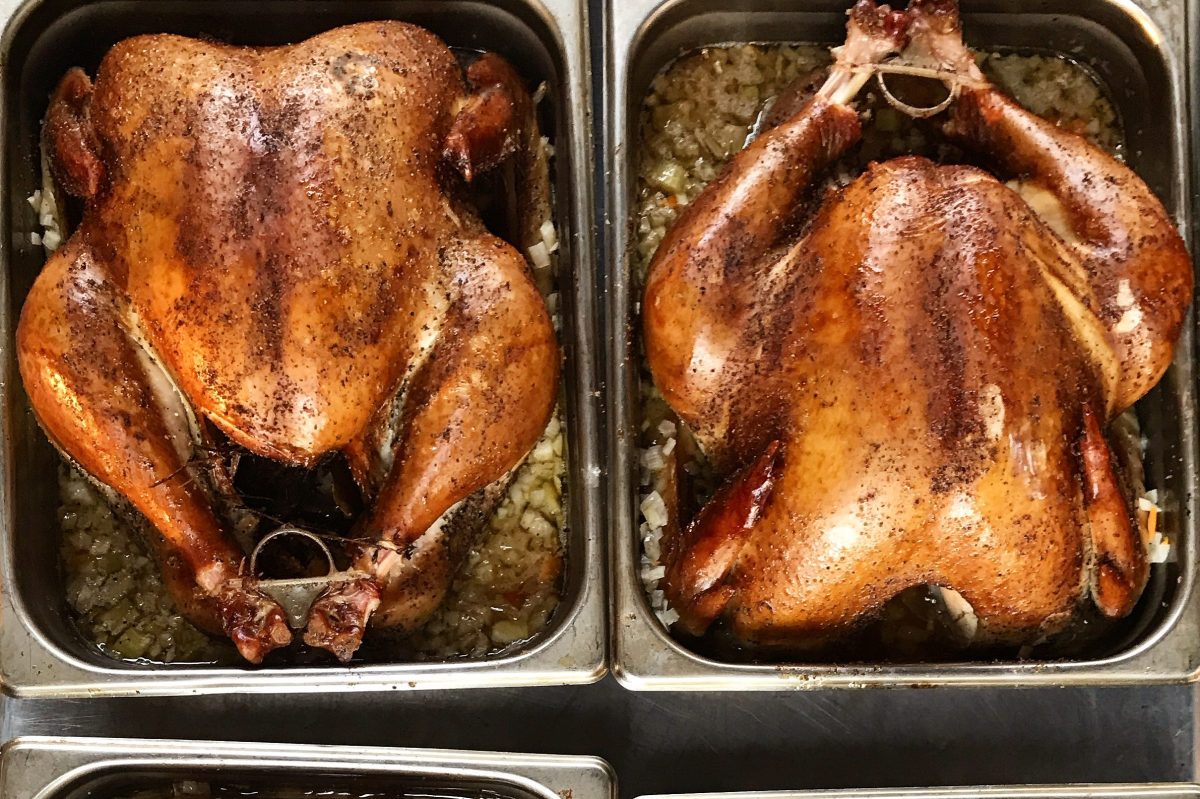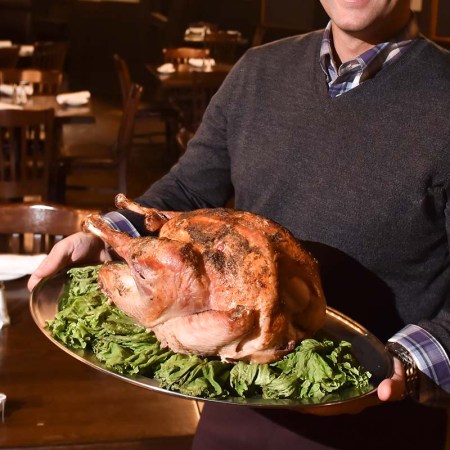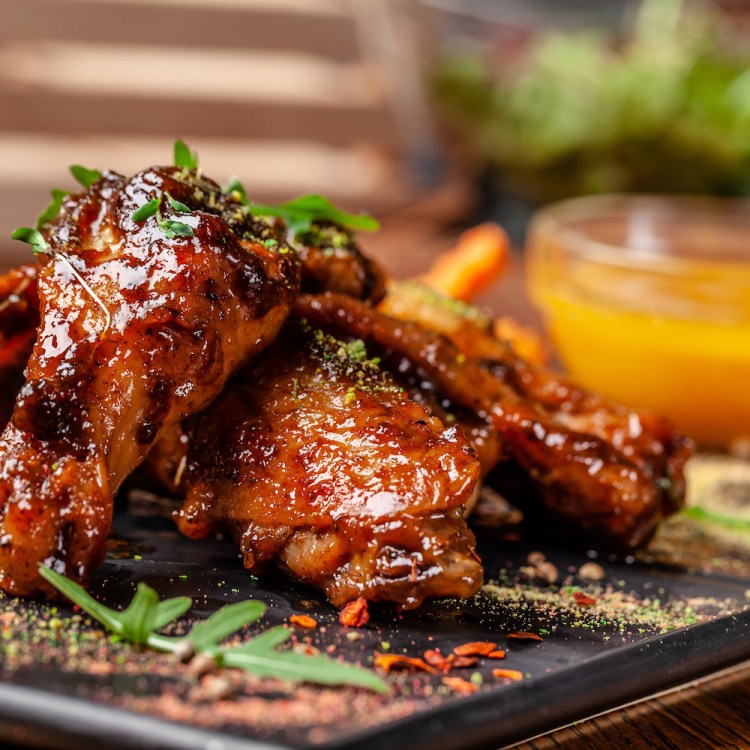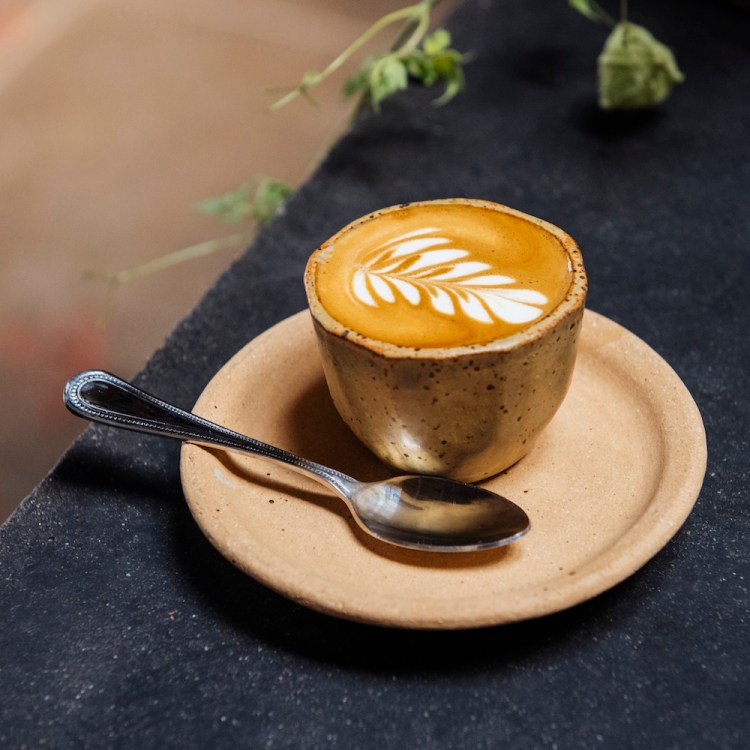Along with mashed potatoes, green bean casserole and pumpkin pie, deep-fried turkey accidents have become an annual Thanksgiving tradition.
And we get it. Deep-frying a turkey is a great way to make a memorable Thanksgiving meal that won’t bring back memories of grandma keeping the bird in the oven until it was drier than a popcorn fart. But using a turkey torch (what some fire departments call deep-fat turkey fryers) is also a great way to replace Thanksgiving dinner with a trip to the emergency room. So if you’re looking for an alternative method of cooking your bird that doesn’t involve the oven, don’t fry your turkey — Smoke it.
How, you may ask?
We turned to Chef Matt Abdoo of Pig Beach, a destination for smoked meats that planted its flag in Brooklyn and recently opened a new location in Long Island City in Queens, to get five basic smoked turkey commandments as well a full recipe with ingredients and step-by-step instructions.
“You’re going to want to smoke a turkey because the flavor is so much different and so enjoyable. It also gives such a beautiful color that the centerpiece of your Thanksgiving will look like it came out of a Betty Crocker or Martha Stewart magazine. The smoke gives the entire exterior of the turkey a gorgeous mahogany color that just makes it look enticing. The flavor of that smoke also just brings it to the next level if you like barbecue or if you like smoked meats. Your guests will be super excited about it.”
At least if you follow Abdoo’s tips and Pig Beach’s recipe …
No. 1: Thou Shalt Brine Your Turkey
“Turkeys need to be brined no matter what. That’s going to add so much moisture and flavor to the meat and will basically be the difference between a moist turkey and a dry turkey. Brining also gives you the opportunity to have a lot more forgiveness if the turkey happens to get overcooked a little. The brining adds moisture to combat overcooking. For people who are worried about it getting too dry, the best advice I can give is to make sure you brine, brine, brine. The basics are water, salt and sugar. From there, you can have a lot of fun with aromatics based on what you want the flavor profile of the turkey to be. If you want the inside of that meat to be herbaceous, you add herbs. If you want it to be sweet, you would add sweeter things like clove and nutmeg and cinnamon. If you wanted it to be citrusy, you would add lemon and orange peel.”
No. 2: Thou Shalt Not Stuff Your Turkey
“Smoking a turkey is very different than roasting a turkey. When I smoke a bird, I don’t want to stuff the cavity with stuffing or dressing or whatever you like to call it. You want that smoke flavor to permeate within the cavity to really give that meat a nice, smoky flavor. If you stuff a bird with dressing or stuffing and smoke it, usually what happens is the stuffing ends up getting overly smoky because of the length of time it has to be in the smoker. It doesn’t really correlate or transfer very well to the end result of eating.”
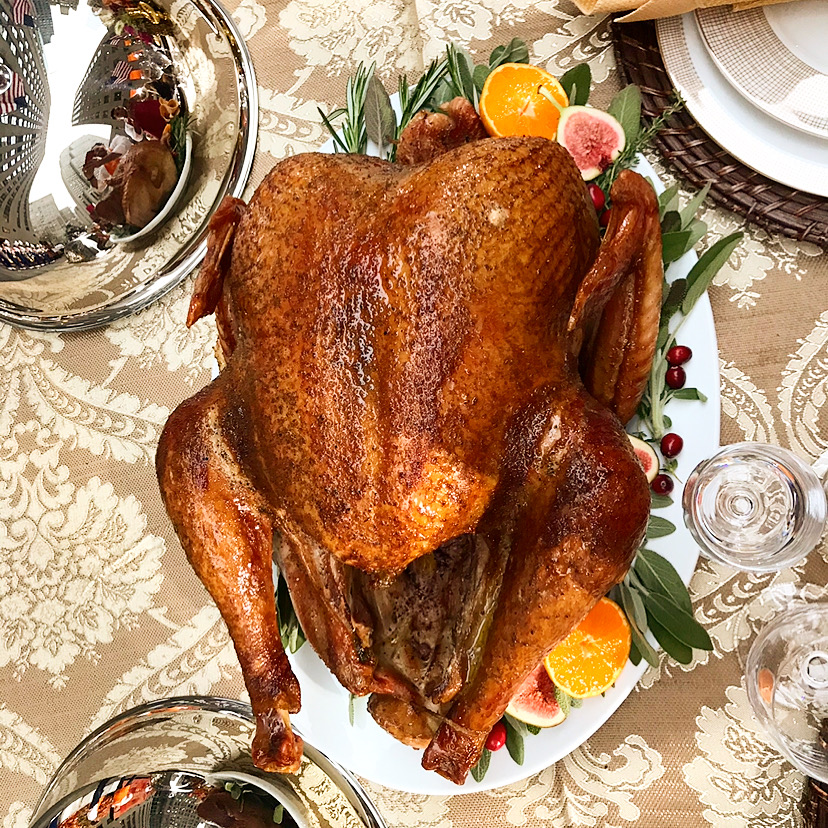
No. 3: Thou Shalt Acquire a Good Thermometer
“Make sure you have a good, reliable instant digital thermometer so you’ll know exactly when that bird gets to the temperature it needs to be and doesn’t surpass 165 degrees in the breast or 175 degrees in the leg and thigh, although the latter two are certainly a lot more forgiving. Make sure you’re cooking it to those specific temperatures and you’ll pretty much be guaranteed to have a juicy, consistently cooked turkey at Thanksgiving — or any day for that matter.”
No. 4: Thou Shalt Spatchcock
“On any whole chicken or turkey, the breast meat and the leg and thigh meat cook up at such different rates that it’s almost impossible to have that perfect cook on all three at the same time because of the nature of how the bird sits when it’s whole. What usually ends up happening is you have a perfectly cooked leg and thigh with a dry breast. One of the best ways to get around that is to spatchcock your turkey. You take out the backbone and basically just lay it flat, which helps get a more even cook on the entire turkey and result in having everything done around the same time. Another way is to cook the legs and thighs separately from the breast, but nobody wants to do that because it doesn’t make for a beautiful centerpiece.”
No. 5: Thou Shalt Not Oversmoke Your Turkey
“One of the things that I always like to preach to anybody that’s doing any kind of barbecuing at all is smoke should be applied in the same way that you apply salt or pepper. It should be used as a seasoning. Smoking is a cooking method, but too much smoke, like too much of any good thing, can be bad. You want to make sure when you’re smoking anything that it has the right amount of smoke flavor. If you continue to smoke something for too long, it’s going to turn into an ashtray and not be enjoyable. The perfect balance of smoke with the brining and the seasoning is what’s going to take a traditional Thanksgiving turkey to the next level.”
No. 5: Thou Shalt Enjoy Your Turkey
“I call the smoked turkey our the barbecue sleeper because it’s the most under-ordered item on the menu. When people do order it, they’re like, ‘Holy shit, that’s good. Why does my turkey not taste like this?’ I think turkey is a perfect vessel for smoking because it’s such a neutral flavor profile and does very well to take on whatever seasoning or rub you add to it. When smoked turkey is done right, it knocks your socks off because you’re not expecting it to be as good as it is. Everyone’s just so used to having turkey that was cooked at 200 degrees was so dry it was like the scene in National Lampoon’s Christmas Vacation. I think the reason why turkey is not a more-consumed protein throughout the year is because people have had such bad turkey at Thanksgiving.”
Below, find Chef Abdoo’s full recipe for smoking your bird this Thanksgiving.
Pig Beach’s Whole Smoked Turkey
Tools
- Aluminum Roasting Pan
- Roasting Rack
- Digital Thermometer w/ 2 Probes
- Hand-Held Instant Thermometer
Ingredients for the Turkey
- Whole Turkey 12-14 Pounds
- Turkey Brine 3 Gallons
- Salt 3 Tbsp.
- Ground Black Pepper 1 Tbsp.
- Granulated Onion 1 tsp
- Granulated Garlic 1 tsp
- Butter Room Temp 2 Sticks
- Carrots 2 each
- Celery 4 Ribs
- Apple Cider Vinegar ½ Cup
- Apple Juice ½ Cup
- Water ½ Cup
- White Onion 1 each
- Cherry or Fruit Wood 2 Chunks
- Thyme 8 Sprigs
- Garlic Cloves 6 each
- Shallots Cut in Half 2 each
- Bay Leaf 2 each
Ingredients for the Brine
- Water 3 Gallons
- Kosher Salt 2 Cups
- Granulated Sugar 2 Cups
- Bay Leaf 12 each
- Fresh Thyme 1 Bunch
- Black Peppercorns 2 Tbsp.
- Garlic Cloves Smashed 6 each
- Shallots Sliced 3 each
- Ice 4 Cups
Instructions for the Brine
- Combine all ingredients and whisk until the sugar and salt dissolve.
- Line an appropriate-sized cooler with a large trash bag and place the turkey inside. Using a cooler is a great way to save on refrigeration space and a safe way to properly brine your turkey overnight.
- Slowly pour the brine over the turkey and into the trash bag.
- Once the brine is completely poured over the turkey knot off the top of the trash bag to completely submerge the turkey in the brine and close the lid tightly on the cooler.
- Allow the turkey to brine overnight before cooking. Brine for at least one hour per pound.
Instructions for the Turkey
- Preheat your smoker to 250 degrees.
- While the smoker is heating up, remove the turkey from the brine and dry off using paper towels. Once the turkey is as dry as it can be, generously smear room-temp butter all over the skin. Brushing the turkey’s skin with butter before seasoning helps with rub adhesive and flavor development.
- Once the turkey is completely covered with butter, season all over with salt, pepper, granulated garlic and granulated onion. Stuff the inside cavity with thyme, garlic cloves, shallots and bay leaves.
- Using either a roasting pan with a rack or a disposable aluminum roasting pan with a rack, transfer your seasoned turkey to the rack and place inside the roasting pan along with the apple cider vinegar, apple juice and water. Place carrots, celery and onions around the turkey on the rack then place one of the thermometer probes inside the thickest part of the thigh closest to the bone.
- Place the entire roasting pan with the turkey inside your smoker and seal the door with the thermometer wire hanging out connected to its base. (One of the probes should be dangling in the smoker chamber to accurately read the temperature while the other is reading the temperature of the turkey.)
- Allow the turkey to smoke for about three hours or until the internal temperature of the thigh reaches 130 (basting as desired).
- Once the turkey reaches that temp, remove the roasting pan from the smoker and tent the entire roasting pan with foil to prevent too much smoke. Return the tented roasting pan to the smoker and continue to cook an additional 2-3 hours or until the internal temperature of the thigh reaches 160 degrees.
- Remove the turkey from the smoker and remove the foil and allow it to rest for 30 minutes before serving. (The juices should run clear. If there is still a pinkish hue to the juices, the turkey is not done cooking).
Pro Tip: Cook your turkey with enough time so that it can cool to around 120 degrees, then place it under the broiler in your oven to crisp the skin for about 3-5 minutes, turning it as needed. The turkey skin will not get crispy in a smoker at 250 degrees.
Join America's Fastest Growing Spirits Newsletter THE SPILL. Unlock all the reviews, recipes and revelry — and get 15% off award-winning La Tierra de Acre Mezcal.
